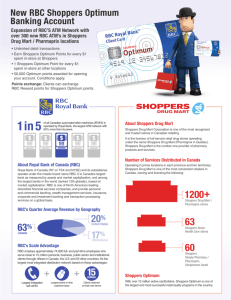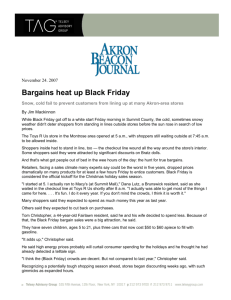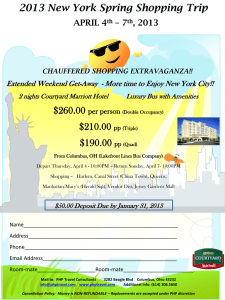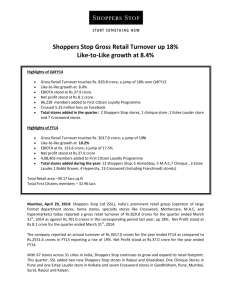ENGL 1301 Division/Classification Powerpoint
advertisement
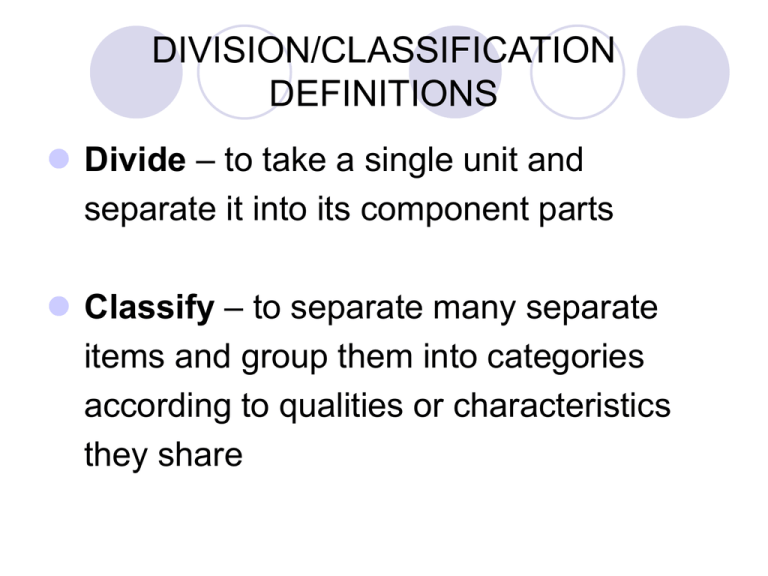
DIVISION/CLASSIFICATION DEFINITIONS Divide – to take a single unit and separate it into its component parts Classify – to separate many separate items and group them into categories according to qualities or characteristics they share DIVISION/CLASSIFICATION Methodology (in general) 1. Select a subject. 2. Decide on a principle for grouping the units of your subject—the characteristics and/or behavior of each class or why each one does something. 3. Establish the groups or classes, which are limited for the scope of this assignment. In other words, there could more than 3 groups. a. Group 1 b. Group 2 c. Group 3 4. Write about the classes. CLASSIFICATION Writing the Classification Essay (shoppers) 1. Select a subject. 2. Decide on a principle for grouping the units of your subject or characteristics of each group or why each group does something. 3. Establish the groups or classes. a. Class one – practical b. Class two – recreational c. Class three – shopaholics 4. Write about the classes. DIVISION/CLASSIFICATION Formal Outline I. First Paragraph: introduction of the thesis. Give background and/or relevant Information, which leads up to the main idea of the essay, the THESIS STATEMENT. This statement should be the last sentence of the paragraph and should include the subject and how it is broken down. Example of Background information about shopping: The basis for the American free enterprise system allows consumers to get the best price when businesses are in competition with one another. Although consumers must shop around in order to get the most for their money and shopping is not enjoyable for everyone, technology has made it easier for people to be more informed shoppers than in the past. There are all kinds of shoppers, three of whom are the practical, the recreational, and finally, the shopaholics (thesis). II. Paragraphs 2-4: Body, which explains the characteristics of the three shoppers. Make sure that in these three paragraphs you give examples of how and why they shop. IV. Paragraph 5: Conclusion. Conclusion with a restatement of the thesis and a review of the main points of the essay. DIVISION/CLASSIFICATION SAMPLE PARAGRAPH 2 (practical shoppers) Practical shoppers are organized, methodical, and economical shoppers. They usually shop with a list and use coupons to get discounts on their merchandise. These consumers expect to get the most for their money because they plan in advance for each shopping trip. They live within their means and are not impulsive shoppers, buying what they need rather than what they want. Typically, they shop alone and are on a time schedule. These customers are willing to pay affordable prices for quality merchandise. Overall, they expect a company’s prices to be fair to appeal to middle-class shoppers on a budget. DIVISION/CLASSIFICATION SAMPLE PARAGRAPH 2 (recreational shoppers) Recreational shoppers want to extend the shopping experience. They like to shop and may overspend, but they also want to enjoy themselves. They may use coupons or expect discounts, but they are in no hurry, as they have allocated enough time for whatever they have planned. Typically these people shop in groups, and after they have finished shopping, they may decide to eat a meal or a snack and perhaps enjoy a movie in the mall. Moreover, they enjoy group interaction. They may be talking on their cell phones, viewing photos, and sending texts to other friends as they shop. DIVISION/CLASSIFICATION SAMPLE PARAGRAPH 3 (Shopaholics) These shoppers are consumed with shopping. They live to spend, and their motto is spend, spend, spend.” These consumers rarely use cash; instead, they rely on credit cards. They are typically impulsive shoppers, buying things they want rather than what they need. Even though these people may have huge credit card debt, they continue to engage in excessive spending. They frequently make minimum payments only when they receive their bills, so they will have more money to spend on shopping. They may decide to use coupons if they have them, but they may buy without them. Regardless of the situation, they overspend. They may justify their many shopping trips by making remarks such as “I deserve it,” or “It’s been a tough week.” If their self-esteem is low, they feel the need to boost it by buying something frivolous. Many shoppers know they cannot afford their purchases when they make them, but it does not deter their spending. They may think to themselves, “I have more time to get the money, so I’ll worry about it later.” However, they fail to realize they may be putting their credit rating at risk because they pay their bills so slowly or not at all. They are not thinking of the future--only the present-- and how much they want the merchandise they are focused on buying. They simply cannot live on a budget, and they refuse to curb their spending. Their excessive buying habits may cause them to seek credit counseling or ultimately, they may be sued for their outstanding debts. DIVISION/CLASSIFICATION SAMPLE CONCLUSION Regardless of what type of shopper a person is, shopping is a necessity in our society. Undoubtedly, technology has made shopping easier, faster, and offers us more variety than ever before. Moreover, today’s consumers are more informed about prices of goods and services because of the comparative shopping on the internet, and purchases can be made with the click of a mouse and a credit card without leaving home. The question we may need to ask ourselves is, “Has the internet made it more convenient for consumers to spend money?” If we are honest, in our response, it is most certainly “yes,” but ultimately, it is the consumers’ responsibility to live within their budget and resist the urge to overspend. DIVISION/CLASSIFICATION Format Outline The following topics listed below are topics that could be classified easily: teachers groceries customers clothing animals neighbors drivers plants liquor CLASSIFICATION Writing the Classification Essay 1. 2. 3. Select a plural subject. Decide on a topic for grouping the units of your subject. Establish the groups of classes. Subject Pet owners Topic why they own Classes companionship to impress others security DIVISION/CLASSIFICATION Writing the Essay Subject Topic Classes Airline flights seating first class, business, coach Drinkers why people drink to get drunk to fit in socially to remove inhibitions; to forget their problems DIVISION/CLASSIFICATION Writing the Essay Subject Illegal drugs Topic why people take them Classes curiosity to fit in socially to raise one’s selfesteem; to alleviate a void in their life







